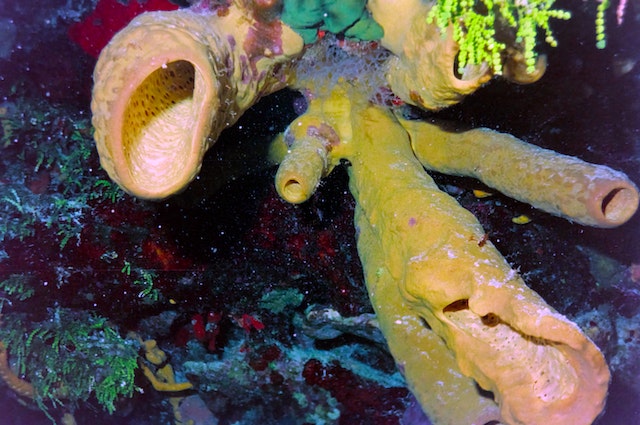
What is a sponge? Sponges are animals that have a very porous skeleton and live in the sea.
When we talk about sponges, we are talking about the organisms and not the sponges we use to wash. Although, the one is based on the other. There is a big trade in diving for and selling natural sponges, but it has declined over the last half century. People used to use sponges as padding, drinking utensils, and water filters. They were also used for washing and even painting. Many sponges are too hard and rough to be used, but there are some that were soft enough and they were wildly used. By the middle of the 20th, overuse and overfishing had almost brought them to extinction. Luckily for the sponges, although unluckily for the environment, synthetic sponges were invented in 1952.
There are 8,500 different species of sponge and they are thought to be the oldest living animals. There are thought to be another 15,000 species that have yet to be found. They live at various depths in the oceans and some are so deep, over 8,000 meters, that it is unlikely we will find them. Fossils have been found that were dated to 600 million years ago. Sponges can be as small as 3 cm and as large as 2 meters. A few species grow at the rate of 0.2 mm a year and some members of that species are 1 meter wide, which could mean that they have been alive and growing for over 5,000 years.
So, what is a sponge? A sponge is an aquatic animal. The majority of them live in the ocean but there are some that live in freshwater. They have a skeleton, but they don’t have a complex nervous system, organs, flesh, or a brain. They cannot move and they attach themselves to a surface under the water so they are not washed away by the sea currents. If they don’t move, have no brain, and no organs, are they really alive? Sponges grow, reproduce, and digest food, which means they are definitely alive and are considered to be animals.
How do animals that cannot move, eat? The secret lies in their porous skeleton. Most sponges consist of a very hard skeleton made of minerals, and a soft layer of cells that grows through it. They don’t have any blood or a circulatory system. They use the seawater in place of blood. The pores in their skeleton are shaped like funnels to let the seawater flow through and into a large central cavity. There is a layer of cells here called collar cells that have tiny hairs attached to them. Bacteria and microorganisms that are washed through by the seawater get caught in the hairs and drawn into the collar cells, where they are digested. The cells in the sponge also need oxygen to survive, and they get this from the water as well. It diffuses out of the water into the sponge’s cells. The sponges produce CO2 and waste material, which is passed back into the water and washed away.
Sponges cannot move so it is very easy for other animals to prey on them. Sponges have evolved two defenses against this. The first defense is toxicity. Some sponges produce chemicals that are toxic to fish and other predators. The second defense is to shed spicules. These are six pointed structures that make up the skeleton of most sponges. They are tiny and needlelike, Sponges can shed these spicules, making a sharp perimeter around them that animals such as starfish cannot get through.
Because sponges filter bacteria, particles and other organisms out of the water, they are a vital part of any ecosystem. They remove pollutants and the waste they produce can be food for other organisms. A single sponge the size of a baseball can filter 5,000 liters of water a day. Some researchers are trying to find a way to use sponges to remove the pollutants out of the seas that we have put there. The sponges can take them out, but the question is what happens to them after they are filtered. There is also the possibility that sponges could be used to clean oil spills out of the oceans or even remove microplastics. Sea sponges can also live in a wide range of water temperatures, so they could potentially also survive the warming of the oceans. And this is what I learned today.
Sources
https://www.inspiritvr.com/general-bio/invertebrates/sponges-study-guide
https://oceanservice.noaa.gov/facts/sponge.html
https://en.wikipedia.org/wiki/Sponge
https://en.wikipedia.org/wiki/Sponge_spicule
https://spongis.org/what-are-sponges/
https://www.mrsd.org/cms/lib/NH01912397/Centricity/Domain/245/sponges%20reading.pdf
https://ec.europa.eu/research-and-innovation/en/horizon-magazine/cleaning-power-sea-sponges#:~
